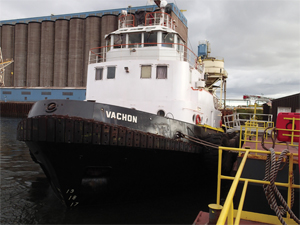A Quebec tugboat was damaged when it became caught between a breakwater and the bulk carrier it was assisting because a strong ebb tide pushed the ship off course and the tug’s tow-abort mechanism failed.
Those were the findings of the Transportation Safety Board of Canada (TSB) investigation into the damage to the tug Vachon when it was engaged with the tug Brochu to dock the bulk carrier Orient Crusader in Port-Cartier on Sept. 12, 2014. Vachon struck a breakwater after an unsuccessful abort attempt.
“The pilot did not fully appreciate the extent to which the current was setting the vessel to the east and corrective actions were not effective in returning the vessel to the recommended track,” the TSB investigators wrote in a 2015 report.
The private harbor on the outer stretch of the St. Lawrence River is owned and operated by ArcelorMittal Mines Canada Inc. The company owns Vachon and Brochu. Vachon is 99 feet long and powered by two high-speed diesel engines driving two cycloidal-drive propulsion systems. It has a maximum bollard pull of 35 tons.
Prior to the incident, the 837-foot Cyprus-registered Orient Crusader was proceeding inbound toward the Port-Cartier dock when Brochu put a pilot on board. Brochu then passed a towline up to Orient Crusader and secured to the vessel’s starboard quarter with its bow pointing in the same direction as Orient Crusader.
Shortly afterward, at about 2024, Vachon passed a towline up and secured to the starboard bow. Vachon was positioned with its bow pointing toward Orient Crusader’s stern. Vachon’s crew consisted of the master, engineer and seaman.
Orient Crusader’s bridge team consisted of the master, pilot, third officer and helmsman.
Orient Crusader was on a heading of 018° T at a speed of 4 knots, but its course made good (CMG) was 035° T due to the effect of the prevailing current. The vessel’s position was approximately 130 feet east of the recommended track indicated by the range lights, and the pilot was attempting to bring the vessel onto the range lights by altering course. By 2030, the vessel’s heading was 005° T, its CMG was 019° T, and its speed was 3.7 knots. Its position was then approximately 300 feet east of the recommended track, and outside the approach channel.
“Monitoring by the Orient Crusader’s bridge team did not identify the developing unsafe situation with respect to the Vachon’s proximity to the breakwater,” the TSB wrote.
The pilot requested Vachon to “push 6,” which Vachon attempted. But as sea room diminished, the master of Vachon applied increasing power up to “push 10.”
As the bow of Orient Crusader arrived abeam of the breakwater, the master of Vachon realized it would not clear the breakwater and decided to abort the tow. The tow abort mechanism failed to release and at approximately 2035, Vachon’s port side struck the breakwater. Shortly after, the tension on the towline decreased, allowing the line to release.
Once the engineer checked Vachon for damage, both Vachon and Brochu completed docking Orient Crusader. Vachon sustained some structural damage on the port side of the bridge that included a broken stay, a shattered window and a cracked door. The propeller guard and blades incurred minor damage in the form of scratches and scuffmarks. The breakwater sustained minor damage to the infrastructure. One of the stays was broken and a beam protruding from the breakwater was bent.
In findings as to risk, the TSB stated that “if vessel operators are not testing towing equipment, and regulators are not consistently inspecting it, there is a risk that problems will go unnoticed and the equipment will not function in an emergency situation.”
In November 2015, Transport Canada (TC) instructed inspectors and surveyors to verify that a tug is fitted with both of the remote controls to reduce the vessel’s power, and whether proper communication exists between the tow winch control stations and any conning positions. They should verify the proper functioning of the tow-abort equipment at full power, TC wrote.
Following the incident, Arcelor-Mittal Mines Canada Inc. added an item to its monthly security inspection report requiring a hook test under tension to be undertaken every three months on the tugs.

